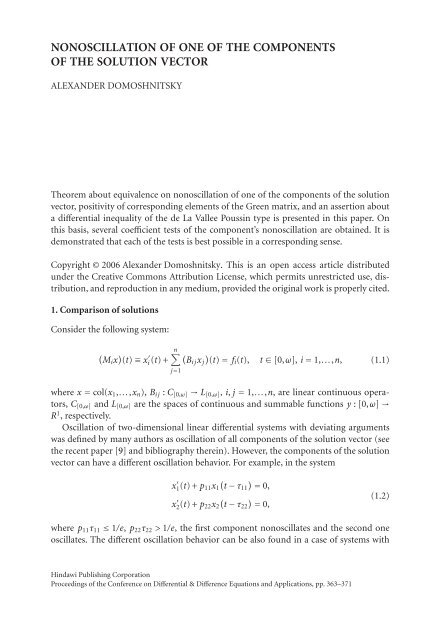DIFFERENtIAl & DIFFERENCE EqUAtIONS ANd APPlICAtIONS
DIFFERENtIAl & DIFFERENCE EqUAtIONS ANd APPlICAtIONS
DIFFERENtIAl & DIFFERENCE EqUAtIONS ANd APPlICAtIONS
You also want an ePaper? Increase the reach of your titles
YUMPU automatically turns print PDFs into web optimized ePapers that Google loves.
NONOSCILLATION OF ONE OF THE COMPONENTS<br />
OF THE SOLUTION VECTOR<br />
ALEXANDER DOMOSHNITSKY<br />
Theorem about equivalence on nonoscillation of one of the components of the solution<br />
vector, positivity of corresponding elements of the Green matrix, and an assertion about<br />
adifferential inequality of the de La Vallee Poussin type is presented in this paper. On<br />
this basis, several coefficient tests of the component’s nonoscillation are obtained. It is<br />
demonstrated that each of the tests is best possible in a corresponding sense.<br />
Copyright © 2006 Alexander Domoshnitsky. This is an open access article distributed<br />
under the Creative Commons Attribution License, which permits unrestricted use, distribution,<br />
and reproduction in any medium, provided the original work is properly cited.<br />
1. Comparison of solutions<br />
Consider the following system:<br />
(<br />
Mi x ) (t) ≡ x ′ i (t)+<br />
n∑ ( )<br />
Bij x j (t) = fi (t), t ∈ [0,ω], i = 1,...,n, (1.1)<br />
j=1<br />
where x = col(x 1 ,...,x n ), B ij : C [0,ω] → L [0,ω] , i, j = 1,...,n, are linear continuous operators,<br />
C [0,ω] and L [0,ω] are the spaces of continuous and summable functions y :[0,ω] →<br />
R 1 , respectively.<br />
Oscillation of two-dimensional linear differential systems with deviating arguments<br />
was defined by many authors as oscillation of all components of the solution vector (see<br />
the recent paper [9] and bibliography therein). However, the components of the solution<br />
vector can have a different oscillation behavior. For example, in the system<br />
( )<br />
x 1(t)+p ′ 11 x 1 t − τ11 = 0,<br />
( ) (1.2)<br />
x 2(t)+p ′ 22 x 2 t − τ22 = 0,<br />
where p 11 τ 11 ≤ 1/e, p 22 τ 22 > 1/e, the first component nonoscillates and the second one<br />
oscillates. The different oscillation behavior can be also found in a case of systems with<br />
Hindawi Publishing Corporation<br />
Proceedings of the Conference on Differential & Difference Equations and Applications, pp. 363–371

















